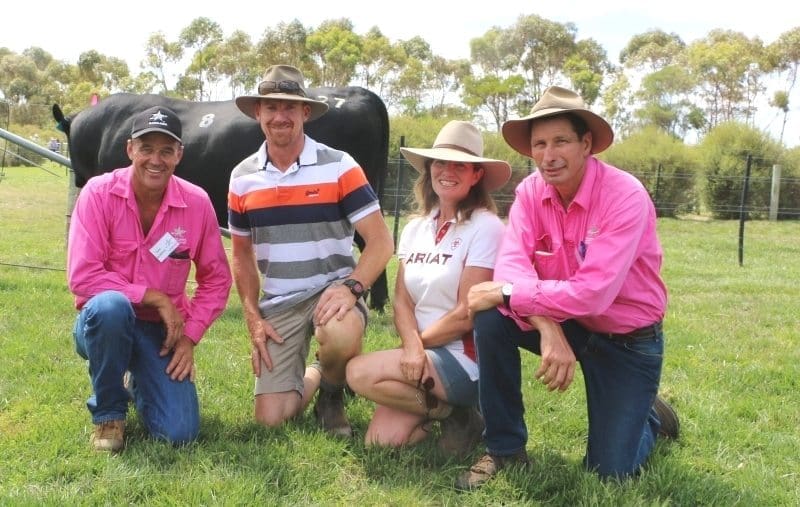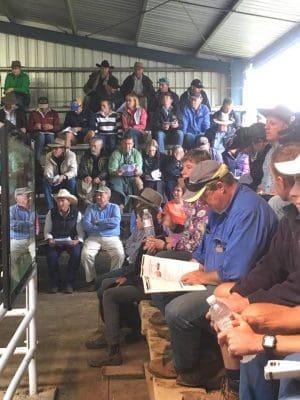ONGOING demand and high prices for commercial cattle, widespread rains in the tropics and a confidence-boosting pre-Anzac Day autumn break in the south have combined to maintain last year’s record-setting bull market during the autumn sales calendar this year.
With the autumn bull selling season now all but over, attention will next turn to spring sales starting in late June. While spring bull selling has traditionally been dominant in Queensland and northern NSW, increasingly southern bull producers are also staging spring sales to cater for southern commercial herds that want to calve-down in spring, rather than autumn.
So far this year Beef Central has recorded results of 132 autumn bull auctions in all states.
Agents and vendors receive some respite during winter, with only 22 smaller sales listed for May and 16 for June, before action again ramps up in July with 42 sales predominantly in northern New South Wales. The focus then shifts further north with 56 sales listed for August, and a back-breaking 84 bull sales in September – an average of four sales for each week-day of the month.
Things quieten down again in October and November, with 15 and 11 sales respectively, mostly in Central and North Queensland – although each will list substantial numbers in their catalogues.
This year’s autumn sales have been dominated by British and European breeds, before the focus turns north for the spring/summer sales where Indicus and tropically adapted breeds build in number.
Angus, Hereford highlights
Not surprisingly, Angus dominated the numbers sold over Autumn. So far this year, 2761 Angus bulls have changed hands at 53 sales for an average of $7366, selling to a top price of $85,000 at Nampara, SA where 66 bulls averaged $9644.
Highlights in the Angus results so far this year are many and widespread. West Australia’s Coonamble Angus average $10,093 for 77 bulls, to set a record for the breed in the west.
In Victoria Te Mania averaged $9282 for a very large catalogue of 156 bulls, while Banquet averaged $9224 for 89 bulls, and Tasmania’s Landfall averaged $8884 for 142 bulls. Victorian based Pathfinder Angus had two southern sales – the stud’s Victorian sale average $8884 for 103 bulls while its South Australia fixture averaged $9336 for 122 bulls.

Jodie and Shane Foster of Boonaroo Angus, Casterton, purchasers of the $30,000 top priced bull at Te Mania ‘s autumn sale last month, with Tom Gubbins and Hamish McFarlane.
The Hereford breed’s autumn average of $6840 for 989 bulls sold almost matches their 2016 average of $6917, although some of the clearances recorded disappointed vendors and agents.
Despite that, there were stand-outs in the Hereford selling rings. Riverina based Injemira sold 93 bulls for an average $9742 while South Australia’s Allendale/Days sale averaged $9150 for 72 bulls.
After many years of selling bulls privately, Yarram Park at Willaura Vic entered the auction arena this year and achieved an $8360 average for 56 bulls.
Other breeds log solid autumn sale results
Simmentals continue to command interest with buyers paying an average of $7763 for the 219 bulls sold so far this year, headed by the $9760 average for 102 bulls at the South Australian stud Woonallee. Last year Simmentals averaged $6829.
The 321 Charolais sold so far in autumn sales this year have averaged $5950, while a resurgent Shorthorn breed, with only a small sample, averaged $8134 for 112 bulls sold so far in 2017.

Part of the large crowd around the sale ring at Spry’s Shorthorn and Angus bull sale on Friday
Heading the Shorthorn results for the autumn circuit was last Friday’s Sprys sale at Wagga Wagga NSW where 40 bulls averaged a very strong $10,600. Spry’s 12 Angus bulls offered at the sale sold to $18,000 to average $11,583, and three Shorthorn females sold to $14,000 and averaged $8333, in an ‘absolute screamer’ of a sale, as described by ebullient auctioneer Tony Fountain in this short youtube video recorded soon after the sale concluded (click here to view).
In a twist, the $23,000 top priced Spry’s Shorthorn bull was purchased by commercial breeder, AM Childs, beating the attending seedstock buyers to secure the 13 month old roan.
Coming up
The half-century-old multi-vendor Hereford National sales at Wodonga on May 10 and 11 and Dubbo on June 5 and 6 still provide an excellent marketplace for industry-leading genetics.
Wodonga, traditionally powered by horned Herefords, has succumbed to the industry-wide push towards natural polls, with 111 polls in this year’s 189-head catalogue. Dubbo, once all polls, has a 100 head catalogue with 12 listed this year as ‘scurred’ and the remainder polls.
These ‘show and sale’ events remain highly popular and successful events in the whiteface world despite disappearing from other major breeds. At the 52nd Wodonga National last year, 141 bulls averaged $9961 while the 77 bulls sold at the 56th Dubbo National averaged $11,854. Both these averages were records for these events and indications are there should be no lack of buyers when the bulls enter the sale rings at Wodonga (May 11) and Dubbo (June 6) for the 2017 sales.
These sales coincide with the end of a turbulent 12 months for Hereford Australia’s chief executive Dr Alex Ball, who has decided to quit following his predecessors John McKew and Warren Clark out the door in the past five years.
One event the Angus seedstock industry is eagerly awaiting is the first stage dispersal of Lock Rogers’ Wattletop herd at Guyra NSW with 270 females offered on May 25. A further 270 younger herd-mates will go under the hammer in 2018.
Also looking ahead, to spring, the annual Rockhampton Brahman Week Sale, this year on October 2 to 4, overshadows all the multi-vendor sales in Australia on size. Last year at Rockhampton 826 Brahman bulls grossed almost $10 million, sold to a top of $150,000 and averaged an unbelievable $11,715.
Unconfirmed reports indicate over 1000 bulls are nominated for the 2017 sale and a meeting later this week will grapple with the challenges attached to such a huge numbers of entries. Rocky Brahman Week is certain to retain its billing as the world’s biggest single breed bull sale, but even in its current three-day form, is only a shadow of the days when it sold close to 1600 bulls over four full eight-hour selling days, in the 1990s.
So what is in store for bull sales for the remainder of 2017? Last year prices got better in the second half. Let’s hope for more of the same this time around.
Seasonal recess for Genetics Central
Our weekly industry reviews on Genetics Central will go into seasonal recess after today’s report – returning for the spring 2017 bull selling season across Australia at the end of June, for the run starting in southern states and extending north into Queensland right through to November.
In the meantime, our popular Upcoming bull sales and Recently completed bull sales summaries will remain up-to-date. If you notice any oversights in our calendar in advance of the spring bull selling calendar please notify us via this link.



HAVE YOUR SAY